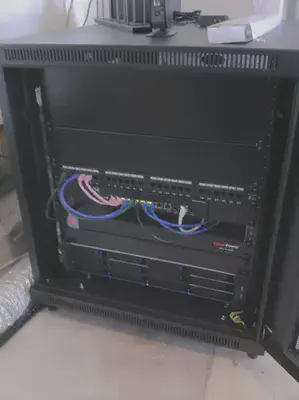Building A SmartOS Server
I've been reading about SmartOS for awhile now and have wanted to build a home server that would let me run VM's with ZFS for the main file-system. Getting rid of my home theater PC and wireless router (which has been annoying me with its flakiness for months) was also a goal. Running something like pfsense in a VM would give me more options and theoretically be more stable than the fairly crappy software that seems to plague home consumer-grade wireless routers.
So after a month or so of research in my spare time, it seemed like SmartOS was going to be the best bet. Even though its generally intended for use in the datacenter, it had all the features I wanted (which I'll blog about separately in my next post). Now I just needed a parts list that had already been verified to work with SmartOS, which is a bit pickier on hardware than the linux/BSD distributions.
Equipment
Here's what I ended up with:
- CPU: Intel Xeon E3-1230 V2
- Motherboard: SUPERMICRO MBD-X9SCL-F-O
- Case: NORCO RPC-2212 Black 2U Rackmount Server Case with 12 Hot-Swappable SATA/SAS Drive Bays
- HBA: LSI Internal SATA/SAS 9211-8i (Hooks up to 2 of the back-plane connectors in the case for 8 drives)
- RAM: 16GB ECC (The 8 GB unbuffered sticks were unfortunately not around at the time or I would've gotten two of those to begin with)
I already had a 2TB and 3TB drive, so I bought one more of each so that I could run a ZFS storage pool with 2 vdev mirrors as Constantin Gonzalez blogs about regarding RAID vs. mirrors.
In retrospect, and after reading a bit more, I think I would've gotten one of the larger Norco 4U cases. Not because I need or want 20+ hot-swap bays, but because you can easily use a 'desktop' grade 80+ Titanium rated power supply. Finding a 2U 80+ PSU is difficult, a 80+ Titanium rated that puts all its power out on a single 5v rail is almost impossible. The cost savings in getting a good desktop-grade PSU with the Norco 4U case is about the same as the one I got with the more expensive 2U PSU.
I also bought a rack to put the server in along with my other home networking gear, so that it'd all be nicely packed away in a corner of the garage. Here's a photo of the completed setup:

I have one of the cheaper Cisco SG300-10 switches which conveniently came with rack-mounts, and monoprice had a very affordable patch panel and blank plates to make it look tidy.
Overall cost: ~$2200
That includes the nice Tripp Lite SR12UB 12U Rack Enclosure which I've found handy to lock to ensure my toddler doesn't yank out hard drives (he figured out how to pull out the hot-swap drive in all of 20 seconds when I was assembling it). Not that I let him run around the garage, but keeping everything locked is handy just in case.
OS Choice
When I was assembling and preparing to install SmartOS, some people on IRC mentioned that OpenIndiana might be a better choice for a home server. Suffice it to say it didn't work out well, while SmartOS has been flawless now and running smoothly for the past two months.
My next post will have a lot more details on my OpenIndiana experience as well as how I have the SmartOS box setup.